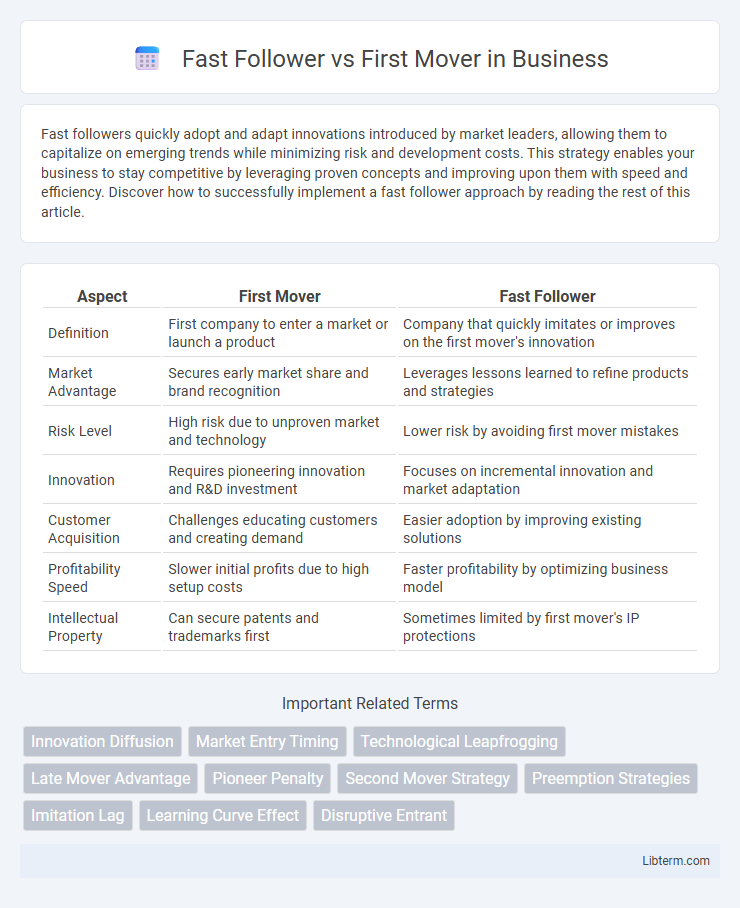Fast followers quickly adopt and adapt innovations introduced by market leaders, allowing them to capitalize on emerging trends while minimizing risk and development costs. This strategy enables your business to stay competitive by leveraging proven concepts and improving upon them with speed and efficiency. Discover how to successfully implement a fast follower approach by reading the rest of this article.
Table of Comparison
| Aspect | First Mover | Fast Follower |
|---|---|---|
| Definition | First company to enter a market or launch a product | Company that quickly imitates or improves on the first mover's innovation |
| Market Advantage | Secures early market share and brand recognition | Leverages lessons learned to refine products and strategies |
| Risk Level | High risk due to unproven market and technology | Lower risk by avoiding first mover mistakes |
| Innovation | Requires pioneering innovation and R&D investment | Focuses on incremental innovation and market adaptation |
| Customer Acquisition | Challenges educating customers and creating demand | Easier adoption by improving existing solutions |
| Profitability Speed | Slower initial profits due to high setup costs | Faster profitability by optimizing business model |
| Intellectual Property | Can secure patents and trademarks first | Sometimes limited by first mover's IP protections |
Introduction to Market Entry Strategies
First movers capitalize on being pioneers by introducing innovative products or services to untapped markets, securing early customer loyalty and brand recognition. Fast followers observe first movers' successes and challenges, then quickly introduce improved or more cost-effective alternatives to capture market share with reduced risk. Effective market entry strategies balance innovation speed and risk management to optimize competitive advantage and long-term growth potential.
Defining First Mover Advantage
First mover advantage refers to the competitive edge gained by a company that is the first to enter a new market or develop a novel product, establishing strong brand recognition and customer loyalty early on. This early entry allows the first mover to set industry standards, secure critical resources, and create high switching costs that deter later competitors. However, the first mover must also bear the risks of market uncertainty and high research and development costs, which can sometimes be exploited by fast followers.
Characteristics of Fast Followers
Fast followers capitalize on the market insights and initial adoption challenges faced by first movers, allowing them to refine products and strategies based on observed successes and failures. They typically exhibit agility in innovation, rapid market entry, and effective resource allocation to optimize customer adoption and operational efficiency. By leveraging established market demand and avoiding early market uncertainties, fast followers often achieve faster scalability and competitive pricing advantages.
Key Benefits of Being a First Mover
First movers secure a significant competitive advantage by establishing strong brand recognition and customer loyalty before rivals enter the market. They benefit from setting industry standards and capturing the largest market share, which leads to higher long-term profitability. Early access to valuable resources, including patents and supplier relationships, further strengthens their market position.
Core Advantages of Fast Follower Strategy
Fast follower strategy leverages market insights from first movers to minimize risks and reduce development costs, enabling quicker adaptation to customer preferences and emerging trends. This approach benefits from improved technology and operational efficiencies, often allowing fast followers to offer superior products or services at competitive prices. By avoiding the pitfalls faced by pioneers, fast followers can strategically capture significant market share with optimized timing and resources.
Risks and Challenges for First Movers
First movers face significant risks including high research and development costs, market uncertainty, and the challenge of educating consumers about a new product or technology, which can delay adoption and profitability. There is also the possibility of competitors quickly imitating or improving innovations, leading to loss of market share and diminished returns on initial investment. These challenges require first movers to invest heavily in innovation, branding, and scale-up processes while navigating uncharted market dynamics.
Obstacles and Threats for Fast Followers
Fast followers face significant obstacles including rapid market entry challenges and limited brand recognition compared to first movers. They often encounter threats from intellectual property constraints, established customer loyalty toward pioneers, and the pressure to innovate quickly to avoid being perceived as mere imitators. Competitive differentiation and the ability to scale operations efficiently remain critical hurdles for fast followers striving to capture market share.
Famous Examples: First Movers vs Fast Followers
Amazon exemplifies first movers by pioneering online retail, establishing a dominant market presence early. Facebook, a fast follower, capitalized on social networking trends by improving upon early platforms like MySpace, achieving rapid growth. Tesla, as a first mover in electric vehicles, defined the industry, while companies like Rivian act as fast followers, leveraging Tesla's advancements to capture market share.
Strategic Considerations for Businesses
Fast followers capitalize on the pioneering efforts of first movers by rapidly adapting and improving innovations, reducing risks associated with market uncertainties. Strategic considerations include assessing resource allocation for speed-to-market and leveraging market feedback to refine products or services more effectively than first movers. Businesses must balance the advantages of early market entry with the benefits of learning from initial market dynamics to optimize competitive positioning.
Choosing the Right Approach: What Fits Your Market?
Choosing the right approach between Fast Follower and First Mover depends on market dynamics, competitive intensity, and innovation pace; First Movers gain early market share and brand recognition but face high risks and development costs. Fast Followers capitalize on proven market demand, refining products with lower risk and rapid adaptation to customer feedback, which suits highly competitive or fast-evolving sectors. Analyzing customer behavior, technological trends, and barriers to entry ensures strategic alignment with market conditions and maximizes long-term success.
Fast Follower Infographic

 libterm.com
libterm.com